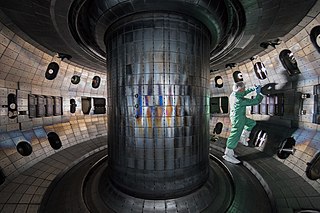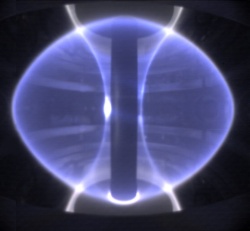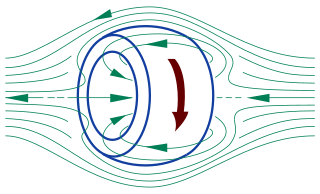
Fatima Ebrahimi is an Iranian-American physicist and inventor. She carries out theoretical and computational plasma physics research for applications including fusion energy and space and astrophysical plasmas. [1] [2]

Fatima Ebrahimi is an Iranian-American physicist and inventor. She carries out theoretical and computational plasma physics research for applications including fusion energy and space and astrophysical plasmas. [1] [2]
Ebrahimi received BSc and MSc degrees in physics from Tehran Polytechnic in 1993 and 1996, respectively, and a PhD in plasma physics at the University of Wisconsin–Madison in 2003 under the supervision of Stewart Prager. [3] [2] Her approach to plasma physics has been characterized as "applying knowledge from her fusion research in the laboratory to astrophysics and vice versa". [2] She is a principal research physicist at the Princeton Plasma Physics Laboratory Theory Department and an affiliated research scholar at the Department of Astrophysical Sciences, Princeton University. [4]
Ebrahimi's most notable contribution to science has been her research on how plasmoids (plasma objects enclosed by magnetic fields) can be used to create the initial plasma current in compact spherical tokamaks [5] [6] and produce thrust for space propulsion. [7] [8] [9] [10] [11] [12] Her proposed electromagnetic plasma thruster utilizes magnetic reconnection for magnetic-to-kinetic energy conversion, emulating the physical mechanism that generates solar flares. [13] Simulations on NERSC supercomputers [14] demonstrated that thrust is generated by expulsion of continuously created plasmoids, when magnetic helicity is injected into an annular thruster channel. [15]
Princeton University has a patent pending on the thruster technology, [13] which "may come to be known as the Ebrahimi Drive – an engine inspired by fusion reactors and the incredible power of solar Coronal Mass Ejections". [8] Ebrahimi has also done research on the magnetorotational instability and demonstrated in global simulations its importance for the dynamo of astrophysical disks [16] and for plasmoid reconnection. [17]

A tokamak is a device which uses a powerful magnetic field generated by external magnets to confine plasma in the shape of an axially-symmetrical torus. The tokamak is one of several types of magnetic confinement devices being developed to produce controlled thermonuclear fusion power. The tokamak concept is currently one of the leading candidates for a practical fusion reactor.

Princeton Plasma Physics Laboratory (PPPL) is a United States Department of Energy national laboratory for plasma physics and nuclear fusion science. Its primary mission is research into and development of fusion as an energy source. It is known for the development of the stellarator and tokamak designs, along with numerous fundamental advances in plasma physics and the exploration of many other plasma confinement concepts.

Magnetohydrodynamics is a model of electrically conducting fluids that treats all interpenetrating particle species together as a single continuous medium. It is primarily concerned with the low-frequency, large-scale, magnetic behavior in plasmas and liquid metals and has applications in multiple fields including space physics, geophysics, astrophysics, and engineering.

Fusion power is a proposed form of power generation that would generate electricity by using heat from nuclear fusion reactions. In a fusion process, two lighter atomic nuclei combine to form a heavier nucleus, while releasing energy. Devices designed to harness this energy are known as fusion reactors. Research into fusion reactors began in the 1940s, but as of 2024, no device has reached net power, although net positive reactions have been achieved.
This timeline of nuclear fusion is an incomplete chronological summary of significant events in the study and use of nuclear fusion.

Magnetic reconnection is a physical process occurring in electrically conducting plasmas, in which the magnetic topology is rearranged and magnetic energy is converted to kinetic energy, thermal energy, and particle acceleration. Magnetic reconnection involves plasma flows at a substantial fraction of the Alfvén wave speed, which is the fundamental speed for mechanical information flow in a magnetized plasma.

Magnetic confinement fusion (MCF) is an approach to generate thermonuclear fusion power that uses magnetic fields to confine fusion fuel in the form of a plasma. Magnetic confinement is one of two major branches of controlled fusion research, along with inertial confinement fusion.

A field-reversed configuration (FRC) is a type of plasma device studied as a means of producing nuclear fusion. It confines a plasma on closed magnetic field lines without a central penetration. In an FRC, the plasma has the form of a self-stable torus, similar to a smoke ring.

A spheromak is an arrangement of plasma formed into a toroidal shape similar to a smoke ring. The spheromak contains large internal electric currents and their associated magnetic fields arranged so the magnetohydrodynamic forces within the spheromak are nearly balanced, resulting in long-lived (microsecond) confinement times without external fields. Spheromaks belong to a type of plasma configuration referred to as the compact toroids. A spheromak can be made and sustained using magnetic flux injection, leading to a dynomak.

DIII-D is a tokamak that has been operated since the late 1980s by General Atomics (GA) in San Diego, California, for the United States Department of Energy. The DIII-D National Fusion Facility is part of the ongoing effort to achieve magnetically confined fusion. The mission of the DIII-D Research Program is to establish the scientific basis for the optimization of the tokamak approach to fusion energy production.

The National Spherical Torus Experiment (NSTX) is a magnetic fusion device based on the spherical tokamak concept. It was constructed by the Princeton Plasma Physics Laboratory (PPPL) in collaboration with the Oak Ridge National Laboratory, Columbia University, and the University of Washington at Seattle. It entered service in 1999. In 2012 it was shut down as part of an upgrade program and became NSTX-U, for Upgrade.
A plasma railgun is a linear accelerator which, like a projectile railgun, uses two long parallel electrodes to accelerate a "sliding short" armature. However, in a plasma railgun, the armature and ejected projectile consists of plasma, or hot, ionized, gas-like particles, instead of a solid slug of material. Scientific plasma railguns are typically operated in vacuum and not at air pressure. They are of value because they produce muzzle velocities of up to several hundreds of kilometers per second. Because of this, these devices have applications in magnetic confinement fusion (MCF), magneto-inertial fusion (MIF), high energy density physics research (HEDP), laboratory astrophysics, and as a plasma propulsion engine for spacecraft.

Sir Steven Charles Cowley is a British theoretical physicist and international authority on nuclear fusion and astrophysical plasmas. He has served as director of the United States Department of Energy (DOE) Princeton Plasma Physics Laboratory (PPPL) since 1 July 2018. Previously he served as president of Corpus Christi College, Oxford, since October 2016. and head of the EURATOM / CCFE Fusion Association and chief executive officer of the United Kingdom Atomic Energy Authority (UKAEA).
Ksenia Aleksandrovna Razumova is a Russian physicist. She graduated from the Physical Faculty of Moscow University in 1955 and took a position at the then called Kurchatov Institute of Atomic Energy in Moscow, then USSR. She defended her Ph.D. in 1966, was Candidate in Physical and Mathematical sciences in 1967, and became Doctor of Sciences in 1984. She is laboratory head at the Institute of Nuclear Fusion, Russian Research Centre Kurchatov Institute. Since the beginning she is actively involved plasma physics in research on the tokamak line of Magnetic confinement fusion.

Direct Fusion Drive (DFD) is a conceptual, low radioactivity, nuclear-fusion rocket engine, designed to produce both thrust and electric power, suitable for interplanetary spacecraft. The concept is based on the Princeton field-reversed configuration reactor, invented in 2002 by Samuel A. Cohen. It is being modeled and experimentally tested at Princeton Plasma Physics Laboratory, a U.S. Department of Energy facility, as well as modeled and evaluated by Princeton Satellite Systems (PSS). As of 2018, a direct fusion drive project driven by NASA is said to have entered its simulation phase, presented as the second phase of the concept's evolution.
Masaaki Yamada is a Japanese plasma physicist known for his studies on magnetic reconnection.
Troy Alan Carter is an American plasma physicist and a professor at the University of California, Los Angeles. He was co-awarded the 2002 John Dawson Award for Excellence in Plasma Physics Research for his work on driven magnetic reconnection in a laboratory plasma.
The history of nuclear fusion began early in the 20th century as an inquiry into how stars powered themselves and expanded to incorporate a broad inquiry into the nature of matter and energy, as potential applications expanded to include warfare, energy production and rocket propulsion.

James Wynne Dungey (1923–2015) was a British space scientist who was pivotal in establishing the field of space weather and made significant contributions to the fundamental understanding of plasma physics.
Amitava Bhattacharjee is a theoretical plasma physicist and a professor at Princeton University. He was awarded the 2022 James Clerk Maxwell Prize for Plasma Physics for his work on dusty plasmas and fundamental plasma processes such as magnetic reconnection, magnetohydrodynamic turbulence and dynamo actions, as well as his contributions in connecting laboratory plasmas to astrophysical plasmas.
This article needs additional or more specific categories .(June 2022) |